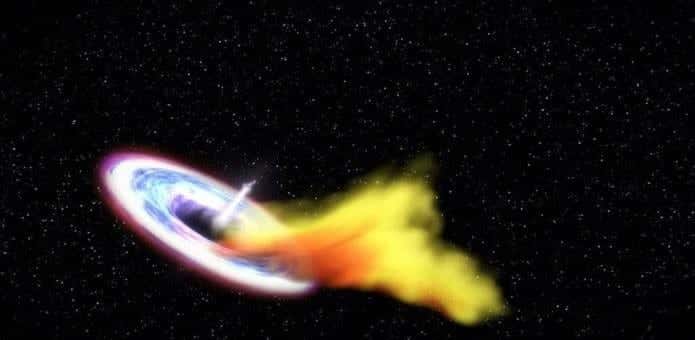Scientists catch black hole eating a star and ejecting it at a high speed flare
For the first time ever, an international team of astrophysicists led by a Johns Hopkins University scientists have caught a black hole eating a star and then ejecting a bit of it moving at nearly the speed of light. NASA has dubbed November 27 as “Black Hole Friday“.
The scientists have tracked a star about as big as our sun as it pulled from its normal path and into that of a supermassive black hole before being eaten up. Then they saw a high-speed flare get thrust out, escaping from the rim of the black hole.
In addition to catching evidence of the star’s destruction – an inevitable death caused by the massive, inescapable gravitational pull of a dense supermassive black hole – the scientists saw a hot flare of matter escape from the scene of the crime.
Known for their voracious appetites, black holes are formed when a massive star collapses upon itself that are occasionally also been described as the “vacuum cleaners” of the universe and are well known for their tendency to cause havoc on the usual laws of physics that govern the rest of the cosmos.
It is the first time anyone has successfully picked up the radio signal produced by this jet of escaping matter say the researchers. While these black hole jets have been noticed before, however, they have never been directly linked to a star being torn apart – and the phenomenon remains pretty mysterious.
These events are extremely rare,” Sjoert van Velzen, who led the analysis, said in a statement. “It’s the first time we see everything from the stellar destruction followed by the launch of a conical outflow, also called a jet, and we watched it unfold over several months.”
“Previous efforts to find evidence for these jets, including my own, were late to the game.”
The deceased star was quite similar to our own. It helped that the galaxy in question is closer to Earth than those studied previously in hopes of tracking a jet emerging after the destruction of a star. This galaxy is about 300 million light years away, while the others were at least three times farther away. One light year is 5.88 trillion miles.
The first observation of the star being destroyed was made by a team at the Ohio State University, using an optical telescope in Hawaii. That team announced its discovery on Twitter in early December 2014.
After reading the tweet about the event, van Velzen contacted an astrophysics team led by Rob Fender at the University of Oxford in Great Britain. That group used different telescopes to gather optical, radio, and X-ray signals from the event as it unfolded, providing a “multi-wavelength” portrait of this event.
The international team had to first rule out that it was coming from the “accretion disk” that is often seen when a star is newly-trapped. The team are now sure that the sudden burst of light from the galaxy that they saw came from a trapped star.
The observation confirms predictions made by current theories, according to the team of researchers, which includes scientists from the United States, the Netherlands, Great Britain and Australia and has been reported in the journal Science.
“The destruction of a star by a black hole is beautifully complicated, and far from understood,” van Velzen said. “From our observations, we learn the streams of stellar debris can organize and make a jet rather quickly, which is valuable input for constructing a complete theory of these events.”

